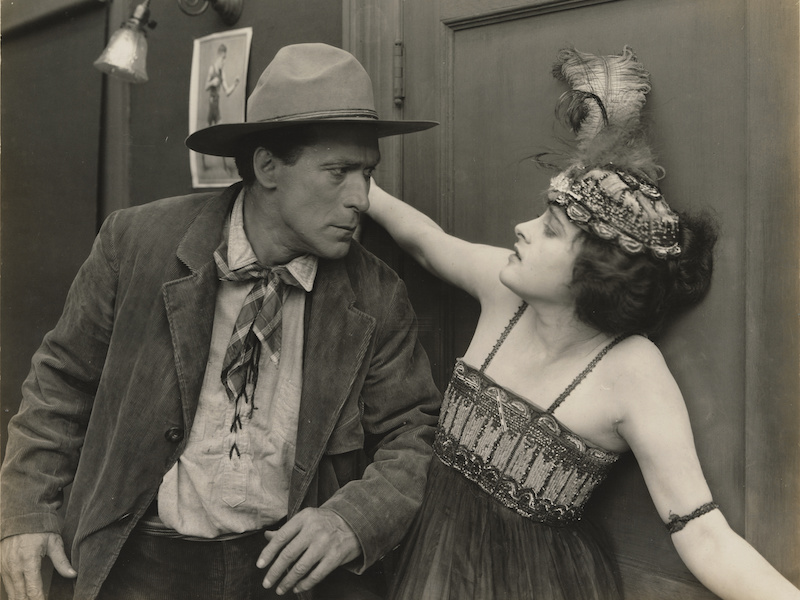THE NARROW TRAIL
Lambert Hillyer, William S. Hart (US 1917)
When “Ice” Harding and his outlaw gang come upon a pinto honored with the name “King,” he succeeds in lassoing the horse and making it his prize mount. The masked gang holds up a stagecoach bound for Saddle City; among its passengers are “Admiral” Bates and his niece Betty Werdin on vacation; “Ice” is stunned by her and refuses to take “jewels from a lady.” A “vigilance committee” pursues the outlaws, and “Ice” leaves the gang when they want to get rid of the pinto, which has become too well known. In Saddle City, Bates poses as Washington, a San Francisco businessman, and “Ice” reciprocates, calling himself Jefferson and pretending to own a ranch in the hills; believing she has met “Jefferson” at some point, Betty refuses to join Bates’s scheme to rob him of the fictional ranch. Both “Ice” and Betty conceal their pasts from one another, and she gives him a false address in San Francisco. When he goes there, he cannot find her, and Halloran tries to shanghai him, taking him to Bates’s saloon, where Betty (“Queen of Barbary Coast”) is ordered to seduce him. Startled, they recognize one another, and “Ice” angrily tries to leave. After fighting off Halloran and his cronies, he returns to Saddle City; later, Betty follows. After “Ice” enters a mile-long horse race, he and Betty meet, apologize to one another, and realize “we need each other real bad.” Discovering that he will be arrested after he wins the race, “Ice” seizes the $1,000 prize and pulls Betty up onto King; they escape a posse and ride off into the “clean, cool mountains.”
Arguably one of Hart’s best westerns, The Narrow Trail evidences excellent direction, camera work, and acting. One expects characteristic moments and scenes, and there are many: high-angle extreme long shots of horsemen racing through canyons or Hart’s lone figure riding into town; “Ice” and his pair of revolvers holding off his gang; the big, complicated fight in the saloon; Hart’s familiar “stone face” in close shots; wary, intimate exchanges between “Ice” and Betty. But some also are unusual. As he leads the vigilance committee away from the rest of his gang, “Ice” and King cross over a chasm on a fallen tree trunk, perhaps reminding Giornate fans of a different stunt (but framed similarly): the stunning human bridge created in Sulla via dell’oro, shown two years ago. What is not shown, according to Motography, is that in one take the tree trunk broke, seriously bruising Hart and his pinto Fritz when they fell into the chasm. When “Ice” recognizes Betty in the saloon, he becomes extremely angry and hostile, belying his name and suggesting how deeply he feels deceived in his love. The story also is unique in having “Ice” and Betty bond through a mutual deception that they have to overcome by accepting not only their disreputable pasts but also the kind of shared guilt that later would define a number of Hitchcock’s paired lovers.
The Narrow Trail was to be the first of Hart’s Artcraft titles under the favorable contract he and Ince concluded with Adolph Zukor in July 1917, and production began on September 1. The contract outlined a two-year series of 16 features for which Hart was to be paid $150,000 per picture, a salary at last commensurate with his box-office status. Ince maintained his right to claim “personal supervision” of Hart’s films, and other benefits. The star’s relations with Ince unraveled during the next year and a half, leading Hart to keep his beloved Fritz out of further films with Ince’s name attached — so Ince would not earn another penny off the sweat of Fritz’s brow. For the moment, however, Hart had what he wanted: his own independent unit at the Lasky studios, while sharing familiar scenarists, directors, and cameramen, and sometimes still Ince’s editorial eye.
Famous Players-Lasky gave generous support to Hart’s first feature, including a budget for location work in San Francisco. But The Narrow Trail was sued by the New York Motion Picture Co. (as part of Triangle’s dissolution) because Hillyer, Sullivan, and Breamer were still under contract to the NYMPC when production began. From late October through late December 1917, as reported in the trade press, an injunction threatened the film’s release, until a judge denied the NYMPC’s case. Although officially released on 30 December, a comment in Motography indicates that Paramount-Artcraft prints circulated widely much earlier, drawing “big business,” as in Duluth, Minnesota. Supposedly in early October, as reported in Motion Picture News, the film even opened “with raised admission prices” in a Seattle theater. “Both Sunday afternoon and evening crowds thronged the streets hoping for admittance. It was reported that at least one thousand were turned away in the afternoon, the same in the evening.”
Richard Abel


regia/dir: Lambert Hillyer, William S. Hart.
sogg/story: William S. Hart.
scen: Harvey F. Thew.
photog: Joe August.
cast: William S. Hart (“Ice” Harding), Sylvia Breamer (Betty Werdin), Milton Ross (“Admiral” Bates), Robert Kortman (“Moose” Halloran), Fritz (“il Re”/“The King”).
prod: William S. Hart Productions/Artcraft, supv: Thomas H. Ince.
dist: Paramount-Artcraft.
uscita/rel: 30.12.1917. c
opia/copy: DCP, 78′; did./titles: ENG.
fonte/source: George Eastman Museum, Rochester, NY.




